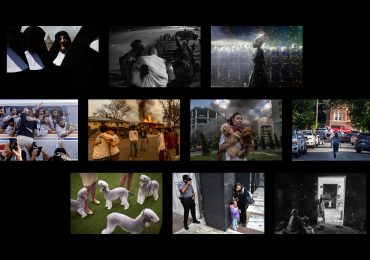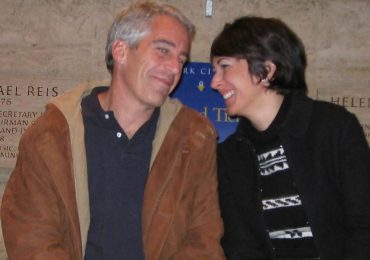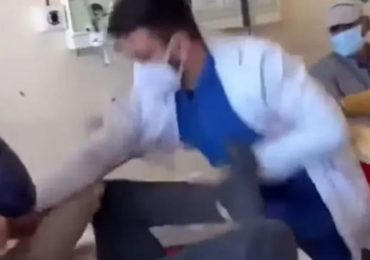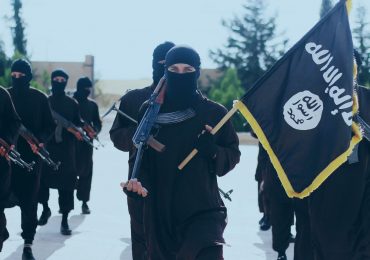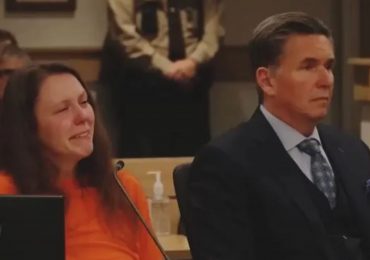THIS is the moment Israeli fighter jets eviscerate terror squads and launchers after a 10-rocket Hezbollah barrage wounded a civilian.
Fears are heightening that southern Lebanon could become a “death zone” after Israeli PM Benjamin Netanyahu vowed to double-down on the terror group with “full force”.
TwitterA ring of fire formed after an explosion in the footage[/caption]
TwitterThe clips show multiple massive explosions in southern Lebanon[/caption]
TwitterThe strikes are in response to Hezbollah firing 10 rockets at Tiberias[/caption]
Footage posted to social media by the IDF shows an unbelievable explosion that results in a ring of fire extending across the bombed landscape.
It then turns into a cosmic fireball that fills the sky.
Another clip shows an aerial point-of-view where Hezbollah’s launchers are blown to smithereens.
Other footage shows rubble and debris flying as the group’s bases continue to be wiped out in southern Lebanon.
The IDF claim in their post on X that Hezbollah’s “military infrastructures, military buildings and terrorist squads” were attacked.
The strikes are in response to Hezbollah firing 10 rockets at Tiberias and other towns near the Sea of Galilee earlier today which resulted in a man being wounded.
The 25-year-old was reportedly hit by falling shrapnel following an interception, The Times of Israel reports.
Israel’s military say most of the rockets were intercepted by air defences.
Yesterday a top Hezbollah chief was eliminated in another airstrike blitz.
After landing in New York and amid talk of a ceasefire, PM Netanyahu backed up his military commander saying the assassination was part of the policy to “keep striking Hezbollah until we accomplish all of our goals”.
Ongoing diplomatic talks to bring a halt to the war have been desperately ongoing as the UK joined the US, France and a host of allies to call for an immediate temporary ceasefire.
The nations called for a 21-day ceasefire “to provide space for diplomacy towards the conclusion of a diplomatic settlement”, as well as a ceasefire in Gaza between Hamas and Israel.
A statement said: “The situation between Lebanon and Israel since October 8th, 2023 is intolerable and presents an unacceptable risk of a broader regional escalation.
“This is in nobody’s interest, neither of the people of Israel nor of the people of Lebanon.
“It is time to conclude a diplomatic settlement that enables civilians on both sides of the border to return to their homes in safety.
“Diplomacy however cannot succeed amid an escalation of this conflict.”
The statement also called for the governments of Lebanon and Israel to “endorse the temporary ceasefire immediately and to give a real chance to a diplomatic settlement”.
But, following hours of silence, Netanyahu clarified that “full force” fighting would continue and reports of a ceasefire were “incorrect”, YNet reports.
U.S Defence Secretary Lloyd Austin said on Thursday that there was a risk of an “all-out war” between Hezbollah and Israel – but added that a diplomatic solution was still feasible.
After meeting with his British and Australian counterparts in London, he said: “We now face the risk of an all-out war. Another full-scale war [could] be devastating for both Israel and Lebanon.
“So let me be clear, Israel and Lebanon can choose a different path, despite the sharp escalation in recent days, a diplomatic solution is still viable.”
All-out war in the Middle East seemed all but inevitable Wednesday night as Israel‘s army chief told his forces to gear up for a land offensive across the border.
AFPAn Israeli fighter jet returning to base flies above an area near Tel Aviv on Thursday[/caption]
EPAThe Israeli Iron Dome air defense system intercepted missiles[/caption]
Western allies were scrambling to broker a temporary ceasefire between Hezbollah and Israel – branding the escalation of violence “intolerable”.
But truce plans went out the window when Israeli Foreign Minister Israel Katz rejected all proposals for a ceasefire with Hezbollah.
In a statement on X he said: “There will be no ceasefire in the north.
“We will continue to fight against the Hezbollah terrorist organization with all our strength until victory and the safe return of the residents of the north to their homes.”
Hundreds of people have been killed this week alone with half a million forced to flee their homes.
It comes as Israel continues to pummel areas of southern Lebanon used by Hezbollah with airstrikes.
Thousands of Brits remain in the country and the military is on standby to evacuate them if Israel does invade.
A pause on hostilities was meant begin in just “hours”, the Telegraph reported earlier today.
Western leaders have been trying to stop the fighting for weeks, with US President Joe Biden saying he fears it would lead to “all-out war”.
Overnight, Lebanon said at least 23 Syrians, most of them women and children, were killed when Israel hit a three-story building in the country.
Another 13 people were also killed and 11 injured in other airstrikes with Israel saying it hit 75 Hezbollah targets in the country.
Around 80,000 Israelis have fled the area after regularly being bombarded by Hezbollah’s rockets following the October 7 terror attack.
Israel’s Channel 12 reported that any deal could include a ceasefire in Gaza, with IDF troops remaining in the strip but not invading Lebanon.
Hezbollah troops would also have to withdraw from the southern Lebanese border, the report claims.
Latest UK government estimates are that there are up to 6,000 British citizens still in Lebanon.
Sir Keir Starmer last night paved the way for troops to launch an evacuation mission if commercial flights stop.
At the United Nations yesterday he called for an immediate ceasefire between Israel and Hezbollah.
Pressed last night on the escalating conflict, the PM said: “I’m not going to get into the details of evacuation plans.
“As you would expect, we put contingency measures in place. But here in New York, in the UN General Assembly, I’m being very, very clear this is a dangerous situation now and all parties need to pull back from the brink, to de-escalate.
“We need a ceasefire and this needs to be sorted out by diplomatic means. Very, very clear messaging on that, very firm messaging on that along with key allies.
“But I am very concerned about the increasing escalation which is not just day on day, but almost hour on hour at the moment.”
The IDF’s Analysis of Hezbollah
by Juliana Cruz Lima, Foreign News Reporter
AN analysis by the Israel Defense Forces (IDF) said that Hezbollah, under the leadership of Hassan Nasrallah, has evolved into a well-armed terrorist organisation, presenting a significant threat to Israeli security.
With strong backing from Iran, Hezbollah’s military capabilities and strategic positioning in Lebanon continue to shape the region’s security dynamics.
Military Strength and Sophisticated Armaments: The IDF assesses that Hezbollah maintains a robust military force with 20,000-25,000 full-time fighters, supported by tens of thousands of reserves.
The organisation’s elite Radwan Unit, trained and equipped by Iran’s Quds Force, is noted for its expertise in conducting operations against Israel, including potential incursions into Israeli territory.
Hezbollah’s vast arsenal consists of over 150,000 rockets and missiles, making it one of the most heavily armed non-state actors globally.
Its weaponry, including Iranian-made Fajr-5 and Zelzal-2 rockets, has the capability to strike deep into Israeli territory, posing a direct and immediate threat.
Advanced Warfare Capabilities: The IDF highlights Hezbollah’s advancements in modern warfare, facilitated by Iranian support.
This includes access to advanced anti-ship missiles, anti-tank weapons, and unmanned aerial vehicles (UAVs).
Hezbollah’s ability to target Israeli naval assets was demonstrated during the 2006 conflict, where it effectively used anti-ship missiles.
The organisation’s UAV capabilities, with ranges up to 400 km, are seen as a growing threat to Israeli airspace and ground operations.
Hassan Nasrallah’s Leadership and Strategy: The IDF acknowledges that Nasrallah has been central to Hezbollah’s development from a militia into a hybrid political-military organization.
Since taking leadership in 1992, Nasrallah has focused on expanding Hezbollah’s rocket arsenal and enhancing its military capabilities.
His extremist ideology, particularly his anti-Semitic rhetoric, reinforces Hezbollah’s hostility towards Israel, while his leadership from hiding underlines the constant threat he poses despite his physical absence from public life.
Major Hezbollah Attacks: Hezbollah has been involved in numerous high-profile terrorist attacks, many of which have targeted Israel and Western interests.
The IDF emphasises that, until 9/11, Hezbollah was responsible for more American deaths than any other terrorist organisation.
It is widely recognised as a global terrorist entity by many nations, including the U.S., the UK, Canada, and Israel.
Hezbollah’s Role in Lebanon’s Crisis: Lebanon’s ongoing economic collapse and political instability have created an environment in which Hezbollah wields disproportionate power.
The IDF warns that Hezbollah’s control and influence over Lebanon’s institutions and its military activities continue to threaten regional stability.
Israel-Hezbollah Conflict: The IDF provides a detailed account of Hezbollah’s ongoing military engagement with Israel, most notably during the 2006 Second Lebanon War.
The conflict, sparked by a Hezbollah attack on Israeli soldiers, resulted in the deaths of hundreds of Hezbollah fighters and significant destruction in Lebanon.
Despite this, Hezbollah has since rebuilt its forces and amassed a larger, more sophisticated arsenal, positioning itself as perhaps the most formidable terrorist organisation in the world.
Conclusion: The IDF concludes that Hezbollah, under Nasrallah’s leadership and backed by Iran, represents a major threat to regional security.
Its advanced military capabilities, particularly its extensive rocket and missile arsenal, coupled with its ideological commitment to attacking Israel, make it a key destabilising force in the Middle East.
As Lebanon faces severe internal challenges, Hezbollah’s role will likely continue to influence the region’s security landscape.
AFPIsraeli Foreign Minister Israel Katz (L) rejected ceasefire proposals on Thursday as Prime Minister Benjamin Netanyahu (R) vowed to double-down on the Hezbollah blitz[/caption]
Half a million Lebanese have already fled their homes
Leave a comment


